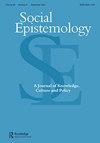Epistemic Bunkers
IF 2
2区 哲学
Q1 HISTORY & PHILOSOPHY OF SCIENCE
引用次数: 2
Abstract
ABSTRACT One reason that fake news and other objectionable views gain traction is that they often come to us in the form of testimony from those in our immediate social circles – from those we trust. A language around this phenomenon has developed which describes social epistemic structures in terms of ‘epistemic bubbles’ and ‘epistemic echo chambers’. These concepts involve the exclusion of external evidence in various ways. While these concepts help us see the ways that evidence is socially filtered, it doesn’t help us understand the social functions that these structures play, which limits our ability to intervene on them. In this paper, I introduce a new concept – that of the epistemic bunker. This concept helps us better account for a central feature of the phenomenon, which is that exclusionary social epistemic structures are often constructed to offer their members safety, either actual or perceived. Recognising this allows us to develop better strategies to mitigate their negative effects.认知掩体
摘要:假新闻和其他令人反感的观点之所以受到关注,一个原因是它们经常以我们直接社交圈中的人——我们信任的人——的证词的形式出现在我们面前。围绕这一现象发展出了一种语言,用“认识泡沫”和“认识回音室”来描述社会认识结构。这些概念涉及以各种方式排除外部证据。虽然这些概念有助于我们了解证据被社会过滤的方式,但它并不能帮助我们理解这些结构所发挥的社会功能,这限制了我们干预它们的能力。在这篇论文中,我引入了一个新的概念——认识地堡。这一概念有助于我们更好地解释这一现象的一个核心特征,即排斥性的社会认识结构往往是为了为其成员提供实际或感知的安全而构建的。认识到这一点,我们可以制定更好的战略来减轻其负面影响。
本文章由计算机程序翻译,如有差异,请以英文原文为准。
求助全文
约1分钟内获得全文
求助全文
来源期刊

Social Epistemology
Multiple-
CiteScore
2.60
自引率
17.60%
发文量
60
期刊介绍:
Social Epistemology provides a forum for philosophical and social scientific enquiry that incorporates the work of scholars from a variety of disciplines who share a concern with the production, assessment and validation of knowledge. The journal covers both empirical research into the origination and transmission of knowledge and normative considerations which arise as such research is implemented, serving as a guide for directing contemporary knowledge enterprises. Social Epistemology publishes "exchanges" which are the collective product of several contributors and take the form of critical syntheses, open peer commentaries interviews, applications, provocations, reviews and responses
 求助内容:
求助内容: 应助结果提醒方式:
应助结果提醒方式:


